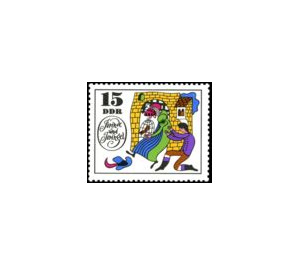Fairy tales: Jorinde and Joringel - Germany / German Democratic Republic 1969 - 15 Pfennig
Theme: Animals
| Country | Germany / German Democratic Republic |
| Issue Date | 1969 |
| Face Value | 15.00 |
| Color | multi-colored |
| Perforation | K 13 1/2: 13 |
| Printing Type | offset |
| Stamp Type | Postage stamp |
| Item Type | Stamp |
| Chronological Issue Number | 1194 |
| Chronological Chapter | GER-DDR |
| SID | 110214 |
| In 20 Wishlists | |
German Fairytale Edition 1969 The Ministry of Posts and Telecommunications of the German Democratic Republic publishes six multi-colored special postage stamps with illustrations from the German fairy tales Jorinde and Joringel. The six stamps are printed on a miniature sheet. Jorinde and Joringel The fairy tale of Jorinde and Joringel is one of the great fairy tales dealing with the persevering, self-sacrificing and perilous search for the entranced or enchanted lover. (According to the international type cat log of Aaarne and Thompson, it is listed as ATh 405). Already in the second half of the 18th century, the fairy tale can be found in a literary monument, to be later included in the Children's and Household Tales (No. 69) by the Brothers Grimm. Henrich Stilling, better known as Jung-Stilling, was born a poor farmer's son in 1740 in Hesse. After hard deprivations and varied destinies he managed to become a doctor, writer and professor at Marbug University. In 1777, Jung-Stilling captured this development, which was extraordinary for the life of a peasant boy in the eighteenth century, in his memoirs "Henrich Stilling's Youth," merging "poetry and truth" and poetically glorifying childhood. So he also embeds the fairy tale of Jorinde and Joringel in an idyllic narrative situation: The boy of about ten hears the fairy tale from his cousin as the children accompany their grandfather to logging in the forest. While the old man works, the children sit at the forest fountain, eat the given milk pudding and enjoy the fairy tale. On the young Henrich the story has a strong effect. This fairy tale, narrated in the solitude of the forest, by the rushing fountain, brings to light for the first time the later romantic theme of forest solitude. With his own poetry, the fairy tale of Jorinde and Joringel found a home in other landscapes and among other peoples. It was told in the Schwalm, it was translated into Swedish, always following the childhood memories of the former peasant boy; it can be found in Irish, Polish, Serbo-Croatian and Russian narrative, and even across the Atlantic. Thus, this fairy tale is proven to last more than two hundred years: Despite the pleading of Joringel, the sorceress leaves with the cage and the Jorinde caged in it and disappears behind the thick walls of her castle (15-pfennig value).


